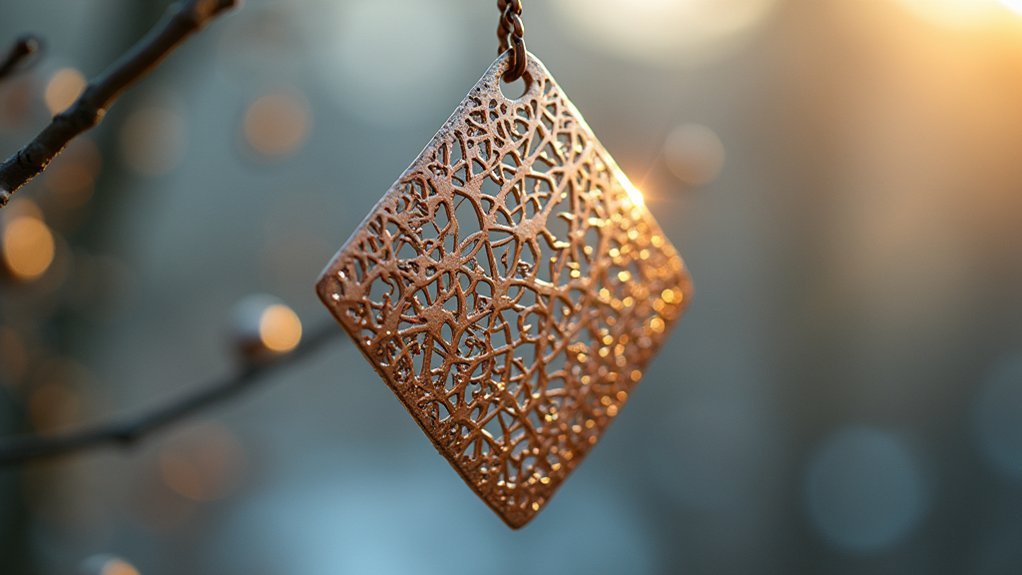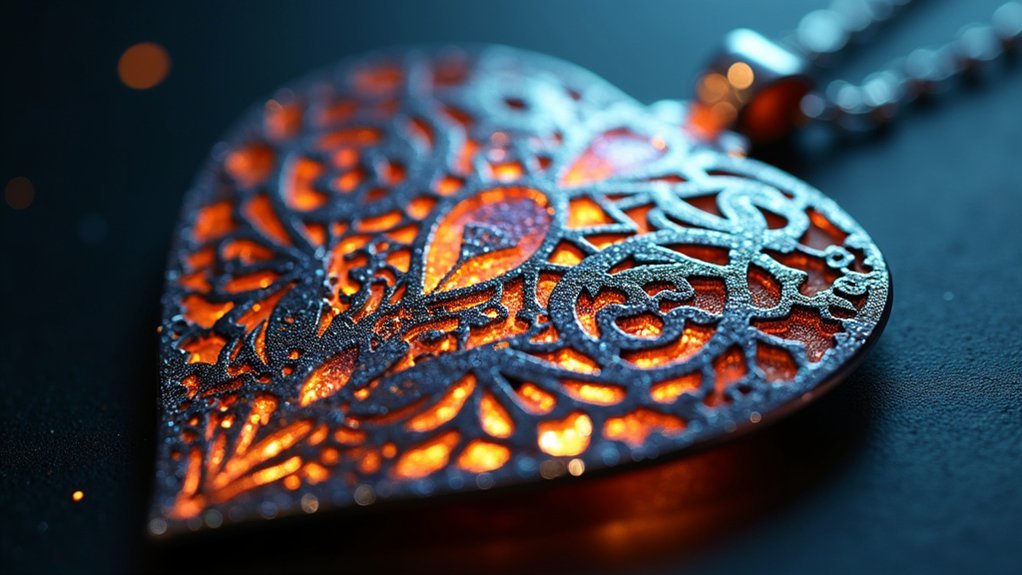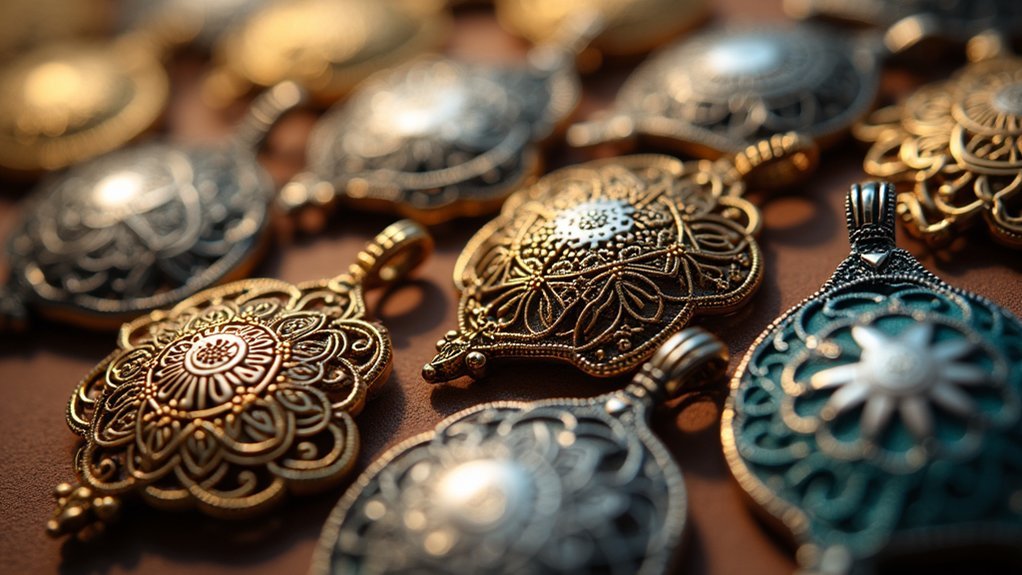Piercing metal for pendant designs creates a mesmerizing interplay of light and shadow that transforms ordinary jewelry into extraordinary wearable art. You’ll achieve a piece that feels substantial yet airy, allowing for bold statements without excessive weight. The strategic balance between positive and negative space adds visual complexity while casting intricate patterns that change with movement. Master this technique to reveal endless creative possibilities that will make your handcrafted pendants truly distinctive.
The Unique Visual Impact of Pierced Metal Pendants

While many jewelry techniques offer aesthetic appeal, pierced metal pendants stand apart through their extraordinary interplay of light and shadow. When you wear a pierced metal piece, you’re not just displaying metalwork—you’re creating a dynamic light show that changes with your movement.
The magic lies in how these pendants transform their surroundings. As light passes through the carefully designed cutouts, it casts intricate patterns that add dimension beyond the physical piece itself.
The strategic balance between positive and negative space in pierced metal creates visual complexity that flat designs simply can’t achieve.
You’ll notice how these pendants feel both substantial and airy simultaneously, allowing for bold statement pieces that don’t overwhelm. This perfect marriage of form and function makes pierced metal techniques particularly versatile for expressing personal style.
Essential Tools and Materials for Metal Piercing Projects
Before starting your metal piercing journey, you’ll need to gather specific tools and materials that guarantee both precision and quality in your pendant creations.
Sterling silver sheet metal at .80mm thickness provides an ideal foundation for your jewelry designs, offering durability while remaining workable.
Your essential tools toolkit should include:
- A saw frame for cutting intricate patterns
- A rotary tool for drilling precise holes
- Polishing wheels for achieving professional finishes
- Design patterns (sourced from line art flowers online)
- Adhesive to secure patterns to your metal surface
Remember to drill appropriately sized holes in designated areas to accommodate your jeweler’s saw blade.
For additional visual interest, consider adding decorative elements like color epoxy to enhance your finished piece.
With these materials and tools at hand, you’re ready to create stunning pierced metal pendants.
Design Principles: Balancing Positive and Negative Space

The interplay between positive and negative space forms the foundation of exceptional pendant design. When creating pierced pendants, you’re working with two vital elements: the metal that remains (positive space) and the areas you remove (negative space).
Remember that all positive space must be interconnected to maintain structural integrity while creating visual flow. Your design should include at least three pierced points to effectively showcase negative space without compromising functionality.
Before finalizing your pendant design, sketch multiple concepts to explore different space relationships. You’ll discover that the right balance transforms ordinary metal into extraordinary jewelry.
The negative cutouts aren’t just empty areas—they’re active design elements that enhance your piece’s overall impact and uniqueness.
Step-by-Step Guide to Creating Your First Pierced Metal Pendant
You’ll need to start with a .80mm thick plate of copper, brass, or nickel for your first pierced metal pendant, ensuring the material is suitable for detailed sawing work.
Mastering the piercing technique requires careful drilling of strategic holes where your design elements intersect, followed by threading your jeweler’s saw blade through these openings.
As you cut along your transferred design, remember to support the metal on a bench pin, keeping your saw blade perpendicular to achieve clean, precise cuts through the negative spaces.
Select Suitable Metals
Choosing the right metal forms the foundation of a successful pierced pendant project. The metal you select impacts both workability and final aesthetic appeal. For beginners, .80mm thickness offers an ideal balance between durability and ease of cutting.
- Copper provides excellent workability and develops a beautiful patina over time.
- Brass offers a golden hue that’s less expensive than actual gold.
- Nickel silver presents a bright, modern appearance without tarnishing quickly.
- Consider your design complexity when selecting material thickness.
- Remember that softer metals are easier to pierce but may dent more readily.
When handling your chosen metal, keep surfaces clean before transferring patterns, as oils from your hands can prevent adhesives from bonding properly.
Allow any glue to fully cure before beginning the piercing process.
Master Piercing Techniques
Mastering the art of pierced pendant creation requires patience, precision, and proper technique. Begin by securing your clean metal plate—preferably .80mm sterling silver or copper—and attach your design pattern with rubber cement. This provides a clear template to follow.
Next, drill at least three strategically placed holes in areas designated for internal cutouts. These access points allow your jeweler’s saw blade to enter the metal. When cutting, make sure to keep the blade lubricated to prevent binding or breakage as you navigate both outer edges and intricate interior details.
After completing all cuts, carefully file and sand the edges until perfectly smooth. This eliminates any sharp or jagged areas that might catch on clothing or skin.
For added dimension, consider filling pierced areas with colored epoxy resin.
Advanced Piercing Techniques for Dramatic Light Effects

While basic pendants may capture attention with their solid form, advanced piercing techniques transform metal into a luminous canvas of light and shadow.
You’ll create stunning visual effects by strategically placing holes that diffuse light in enchanting patterns.
- Use a jeweler’s saw and fine drill bits for precision cutting of complex designs
- Vary hole sizes and shapes to create dynamic light patterns that shimmer in changing conditions
- Experiment with negative space to establish dramatic contrast with solid areas
- Apply epoxy resin color fills to enhance pierced designs with vibrant hues
- Design intricate patterns that maximize the interplay between metal and light
These piercing techniques elevate your pendants from simple accessories to wearable art pieces that interact with their environment, casting mesmerizing shadows and reflections wherever you go.
Finishing Methods to Enhance Your Pierced Metal Designs
Once you’ve completed the intricate cutting of your pierced pendant design, proper finishing techniques will transform it from a rough metal canvas into a polished work of art.
Begin by filing and sanding all edges to eliminate jagged spots and scratches that could diminish your design’s impact.
Next, use polishing wheels to bring out the metal’s natural shine and highlight the pierced patterns. For added dimension, consider applying epoxy resin as color fill, creating vibrant contrast against the metal’s surface.
Don’t overlook functional elements—soldering hinges and pins will increase durability while adding professional refinement.
Finally, attach optional components like bails or hooks to increase versatility, allowing your pendant to function as various jewelry pieces.
Combining Pierced Metal With Other Elements for Stunning Results

Elevate your pierced metal pendants by combining them with colorful epoxy resins or translucent materials to create dramatic mixed media effects that transform ordinary designs into artistic statements.
You’ll discover endless possibilities when you experiment with contrasting textures like smooth glass against intricate metalwork, which highlights the precision of your cutout patterns.
Position your light source strategically behind layered materials to cast enchanting shadows and light patterns that bring your pendant designs to life when illuminated.
Mixed Media Dramatic Effects
When pierced metal meets complementary materials, magic happens in pendant design. You’ll discover dramatic visual contrasts as you combine pierced metal with other elements, creating pieces that capture attention and imagination.
- Pair pierced metal with wood or glass to establish striking texture contrasts.
- Add colored epoxy to cut-out sections for vibrant pops that draw the eye.
- Layer different materials behind your pierced designs to create depth.
- Use light strategically—pierced metal creates fascinating shadow play.
- Combine techniques like etching or stamping with your pierced work.
These mixed media approaches transform your pendants from simple jewelry into wearable art. The interplay between materials doesn’t just enhance aesthetic appeal—it expands functionality, allowing your pierced metal creations to shift from personal adornment to statement art pieces.
Light Play Techniques
The interplay of light through pierced metal creates mesmerizing visual poetry that transforms a pendant from mere jewelry into a dynamic light sculpture. You’ll find that manipulating thickness and pattern complexity dramatically changes how light filters through your designs.
| Technique | Effect | Application |
|---|---|---|
| Epoxy Infusion | Adds color dimension | Fill pierced areas with tinted epoxy for vibrant light projection |
| Metal Layering | Creates depth | Stack pierced elements at varying distances for complex shadows |
| Reflective Backing | Amplifies luminosity | Place mirror-finish materials behind pierced metal to multiply light reflection |
Texture Contrast Combinations
Artful juxtaposition of pierced metal with complementary materials creates visual tension that elevates pendant design to new heights.
When you combine pierced sterling silver with other elements, you’ll achieve striking visual and tactile effects that captivate viewers.
- Pair pierced metal with wood or glass for dramatic texture contrasts that highlight the intricate cut-out patterns.
- Layer with reflective surfaces to amplify the shadow play as light filters through your metalwork.
- Fill cut-outs with colored epoxy for vibrant pops that transform a monochromatic piece into a dynamic statement.
- Integrate leather or fabric to create an intriguing tactile experience—hard against soft.
- Mix pierced sterling silver with brass for metallic contrasts that emphasize the unique characteristics of each material’s finish.
Displaying and Caring for Your Pierced Metal Pendant Creations

After investing time and creativity in crafting intricate pierced metal pendants, you’ll want to showcase and preserve them properly. An elegant jewelry stand provides the perfect display solution, highlighting your pieces while keeping them accessible.
Clean your pendants regularly with a soft cloth to maintain their brilliance. A little bit of clear jewelry wax creates a protective barrier against oxidation, extending the life of your metalwork. Avoid harsh chemicals that can damage your creations.
Gentle maintenance with a soft cloth and jewelry wax preserves your metal pendants’ beauty while keeping harmful chemicals at bay.
When not wearing your pieces, store them in a fabric-lined jewelry box or pouch to prevent scratches. Keep them in a cool, dry place, and remember to remove them before swimming, showering, or applying perfumes.
These simple care practices will guarantee your pierced metal pendants remain stunning for years to come.
Frequently Asked Questions
What Is Piercing in Jewelry Making?
You’re cutting decorative holes in metal sheets using a jeweler’s saw to create intricate patterns. It enhances your jewelry design by adding negative spaces while keeping all positive areas connected.
What Is Piercing in Metal Work?
In metalwork, piercing is when you cut decorative holes in metal sheets. You’ll use tools like jeweler’s saws and drills to create intricate patterns, adding negative space that enhances your design’s visual appeal.
What Metal Should You Get Pierced With?
For your body piercing, you’ll want biocompatible metals like implant-grade titanium, 14k gold, or niobium. Avoid sterling silver, copper, brass, and nickel as they can cause reactions when worn in piercings.
What Is Piercing Metal Called?
Metal piercing is commonly called “pierced metal work” or simply “piercing” in jewelry making. You’ll also hear terms like “openwork” or “reticulation” when jewelers describe the technique of cutting decorative holes through metal.
In Summary
You’ve now learned how metal piercing transforms ordinary pendants into extraordinary wearable art. By mastering these techniques, you’ll create pieces with enchanting light play and visual depth that simply can’t be achieved any other way. Whether you’re a beginner or experienced jeweler, pierced metal designs will elevate your work. Don’t hesitate to experiment—your unique vision and these skills will yield truly stunning results.





Leave a Reply